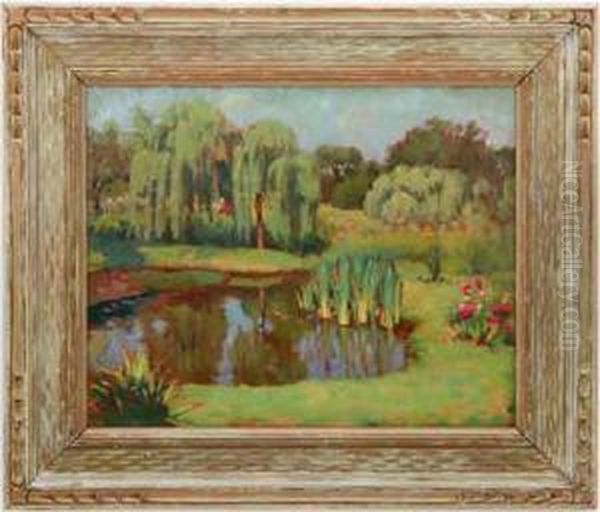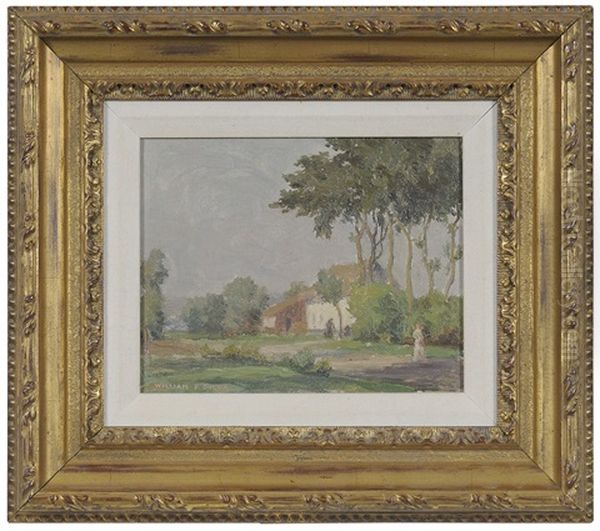
William Posey Silva (1859-1948) stands as a significant, if sometimes overlooked, figure in the tapestry of American art, particularly within the Impressionist movement as it manifested in the American South and California. His journey into the world of professional art was unconventional, beginning much later in life than many of his contemporaries, yet he quickly established a reputation for his evocative landscapes, imbued with a sensitivity to light and atmosphere that defined his distinctive style. Born in Savannah, Georgia, and later making his mark in Tennessee and California, Silva's artistic legacy is characterized by his lush depictions of nature, from the pine forests of his native South to the sun-drenched coastlines and gardens of his adopted California.
Early Life and a Belated Artistic Awakening
Born on October 23, 1859, in the historic city of Savannah, Georgia, William Posey Silva's early life did not immediately point towards a career in the fine arts. He was descended from a family of Portuguese origin, and his formative years were spent in the American South, a region rich in natural beauty that would later profoundly influence his artistic vision. Silva initially pursued a more conventional path, graduating from the University of Virginia with an engineering degree. For many years, he was a successful businessman, managing his family's prosperous chinaware and hardware business in Savannah and later in Chattanooga, Tennessee.
It was not until he reached the age of nearly fifty that Silva made the decisive shift to dedicate his life to painting. This late blooming is a remarkable aspect of his biography. Around 1907, after achieving financial stability, he retired from his business pursuits. This newfound freedom allowed him to fully immerse himself in artistic study and practice, a passion that had perhaps been simmering beneath the surface for years. This transition speaks to a profound inner calling, a testament to the compelling power of artistic expression that could redirect a life already well-established in another field.
Parisian Studies and Impressionist Influences

To hone his burgeoning artistic talents, Silva, like many aspiring American artists of his era, sought training in Paris, then the undisputed epicenter of the art world. He enrolled at the prestigious Académie Julian, a private art school that attracted students from across the globe, including a significant contingent of Americans. At the Académie, he studied under Jean-Paul Laurens, a respected academic painter known for his historical scenes. However, it was the vibrant, revolutionary spirit of French Impressionism that would most significantly shape Silva's artistic trajectory.
While in Paris, Silva would have been directly exposed to the works of the great French Impressionists. The paintings of Claude Monet, with his revolutionary studies of light and color in series like the haystacks and Rouen Cathedral, and Édouard Manet, whose bold compositions and modern subject matter challenged academic conventions, were transforming the artistic landscape. Other Impressionists like Camille Pissarro, Alfred Sisley, and Pierre-Auguste Renoir were also key figures whose work emphasized capturing fleeting moments, the effects of light and atmosphere, and often involved painting en plein air (outdoors). Silva absorbed these influences, adapting their principles to his own developing style. He embraced the Impressionist emphasis on direct observation, broken brushwork, and a brighter palette to convey the sensory experience of being in nature. His first significant exhibition took place in Paris in 1907, marking his official entry into the professional art world.
Artistic Style and Thematic Focus
William Posey Silva's artistic style is best characterized as a form of American Impressionism, with a particular affinity for capturing the unique qualities of the landscapes he inhabited. He was renowned for his depictions of trees, particularly the majestic pines of the South, as well as forests, sand dunes, coastal scenes, and vibrant gardens. His work often exhibits a lyrical quality, a gentle romanticism that coexists with his Impressionistic technique.
A hallmark of Silva's style was his masterful handling of light and color. He sought to capture the ephemeral effects of sunlight filtering through leaves, the soft haze of a Southern morning, or the brilliant clarity of the California coast. His palette, while often bright and characteristic of Impressionism, could also be subtle and tonal, especially in his earlier Southern landscapes. He employed broken brushstrokes to create a sense of movement and vibrancy, allowing colors to mix optically in the viewer's eye.

Silva was a dedicated plein air painter, believing in the importance of working directly from nature to capture its immediacy and truth. This practice allowed him to respond spontaneously to the changing conditions of light and weather, infusing his canvases with a freshness and authenticity. His deep appreciation for the natural world is evident in every brushstroke, conveying not just the visual appearance of a scene but also its emotional resonance. He was particularly drawn to the interplay of light and shadow, and the way atmosphere could transform a familiar landscape into something poetic and evocative.
The Southern Period: Capturing the Spirit of Dixie
Upon returning to the United States from Paris, Silva initially spent time in the South, particularly in Chattanooga, Tennessee, and his native Georgia. During this period, he became one of the most popular painters in the region. His landscapes from this era often depict the characteristic flora and atmosphere of the South: moss-draped oaks, serene swamps, pine forests, and cultivated gardens.
His paintings of Southern scenes were celebrated for their ability to capture the unique charm and languid beauty of the region. Works like "Cravens House," depicting a historic landmark in Chattanooga, showcase his ability to blend architectural elements with the surrounding landscape, imbuing the scene with a sense of history and place. He was adept at conveying the humid, hazy light of the Southern climate, often using a softer, more muted palette than in his later California works. His depictions of Southern gardens, often filled with blooming flowers, further highlight his skill in rendering color and texture. Artists like Elliott Daingerfield, another Southerner who embraced a more Tonalist and later Impressionistic style, were part of a broader movement to capture the distinct character of the Southern landscape.
California Beckons: A New Light, A New Palette
Around 1913, William Posey Silva made a significant move that would profoundly impact the latter half of his artistic career: he relocated to California. He initially settled in Carmel-by-the-Sea, a picturesque coastal village on the Monterey Peninsula that was rapidly becoming a haven for artists, writers, and intellectuals. He would live and work in California for nearly four decades, until his death in 1948.
The California landscape, with its brilliant sunshine, dramatic coastline, and unique flora, offered Silva a new range of subjects and a different quality of light. His palette often brightened in response to the intense California sun, and his works from this period frequently feature the vibrant blues of the Pacific, the golden hues of the coastal hills, and the rich colors of California wildflowers and cultivated gardens. He became a prominent figure in the California Impressionist movement, a regional variation of American Impressionism characterized by its focus on the state's distinctive landscapes and light.
The Carmel Art Colony and Silva's Role
Carmel-by-the-Sea was a burgeoning art colony when Silva arrived, and he quickly became an integral part of its artistic community. The area attracted artists drawn to its natural beauty, affordable living, and supportive, bohemian atmosphere. Silva was in good company, with other notable California Impressionists either residing in or frequently visiting Carmel and the Monterey Peninsula. These included figures like Guy Rose, who had also studied in France and was a leading proponent of French Impressionism in California; E. Charlton Fortune, known for her robust, vibrant depictions of Carmel and Monterey; and Armin Hansen, celebrated for his powerful paintings of the sea and local fishermen.
Silva played an active role in the Carmel art scene. He was instrumental in the establishment of the Carmelita Gallery, located on Ocean Avenue, which served as a venue for local artists to exhibit their work. His own studio and garden in Carmel became subjects for many of his paintings. The "Garden of Dreams" series, for instance, likely drew inspiration from his own cultivated space, showcasing his love for flowers and his ability to create idyllic, light-filled scenes. One such example, "A Cloudy Day in the Garden of Dreams," demonstrates his skill in capturing more diffused light and a softer mood, even within the generally sunny Californian context. His presence helped solidify Carmel's reputation as a significant center for the arts.
Notable Works and Their Characteristics
Throughout his prolific career, William Posey Silva produced a significant body of work, much of which is now held in private and public collections. While a comprehensive list is extensive, certain themes and specific series stand out.
His Southern landscapes, particularly those featuring pine forests and live oaks, are highly regarded for their atmospheric depth and sensitive portrayal of the region's character. "Cravens House" remains an important example of his work from this period, capturing a piece of Tennessee history.
In California, his coastal scenes, depicting the rugged cliffs and crashing waves of the Pacific, became a signature subject. He was equally adept at painting the rolling hills inland, often dotted with California poppies or lupines. The "Garden of Dreams" series is particularly well-known, representing his fascination with cultivated beauty and the interplay of light and color in a garden setting. These works are often characterized by a vibrant palette and a joyful, almost idyllic quality. His depictions of cypress trees, iconic to the Monterey Peninsula, also feature prominently in his California oeuvre.
His works were frequently exhibited and well-received during his lifetime, earning him accolades and a steady stream of patrons. The F.A.M. (Fine Arts Museums) American Impressionist Artists collection includes his work, a testament to his standing within the movement.
Connections with Contemporaries and Artistic Circles
William Posey Silva was an active participant in the art communities where he lived. In the South, he was recognized as one of the leading painters of his time. In California, he was part of a vibrant network of artists. While the provided information doesn't detail specific competitive rivalries, the nature of art colonies often involves both camaraderie and a healthy sense of artistic competition that pushes artists to refine their work.
He was associated with the Salmagundi Club in New York, a prominent arts organization, and exhibited his work widely. His connections in California included artists like Mary Curtis Richardson, a noted portraitist and figure painter; William Raymond Eaton, a landscape painter; and Edith Maguire. The Ross Memorial Museum in St. Andrews, New Brunswick, Canada (though the provided text mentions St. Andrews, CA, the Ross Museum is in St. Andrews, NB, and had connections to artists who summered there, including Silva's friend George Horne Russell, a Montreal artist), holds works by Silva and these contemporaries, suggesting a network that extended beyond California. It's plausible Silva spent time or exhibited in St. Andrews, NB, given Russell's presence there.
Other prominent California Impressionists active during Silva's time, whose work he would have known and with whom he may have interacted, include Granville Redmond, known for his vibrant poppy fields and Tonalist nocturnes; William Wendt, often called the "dean" of Southern California landscape painters for his powerful, structured depictions of the land; and Franz Bischoff, celebrated for his floral still lifes and later, his Impressionistic landscapes. The broader American Impressionist scene included figures like Childe Hassam, John Henry Twachtman, and J. Alden Weir of "The Ten American Painters," whose work set a national standard for Impressionism. While Silva's primary spheres were the South and California, the national artistic currents would have been known to him.
Exhibitions, Collections, and Recognition
William Posey Silva's work was regularly featured in exhibitions throughout his career, both in solo shows and group exhibitions. He participated in significant expositions, including the Panama-Pacific International Exposition in San Francisco in 1915, where he won a silver medal, a notable achievement that solidified his reputation on the West Coast. He also received a silver medal at the Appalachian Exposition in Knoxville, Tennessee, in 1910 and a gold medal at the Mississippi Art Association in 1918.
His paintings found their way into numerous important public and private collections. Besides the F.A.M. American Impressionist Artists collection and the Ross Memorial Museum, his works are held by institutions such as the Morris Museum of Art in Augusta, Georgia (which focuses on the art and artists of the American South), the Ogden Museum of Southern Art in New Orleans, the Irvine Museum Collection at the University of California, Irvine (specializing in California Impressionism), and the Monterey Museum of Art. The presence of his work in these diverse collections underscores his significance in both Southern and Californian art history. Auction houses like Neal Auction Company and Charlton Hall have frequently handled his works, indicating a continued market appreciation for his paintings.
Legacy and Enduring Appeal
William Posey Silva passed away in Carmel, California, on February 10, 1948, leaving behind a rich legacy as a dedicated and skilled interpreter of the American landscape. His late start in art did not hinder his ability to achieve significant recognition and produce a substantial body of work that continues to be admired. He is remembered as a key figure in the Southern art scene of the early 20th century and as an important contributor to the California Impressionist movement.
His enduring appeal lies in the beauty and sincerity of his vision. His paintings offer viewers a glimpse into the landscapes he loved, rendered with a sensitivity to light, color, and atmosphere that transcends mere representation. They evoke a sense of peace, a deep connection with nature, and an appreciation for the fleeting moments of beauty that surround us. He successfully bridged the artistic traditions of the American South with the burgeoning art scene of California, creating a body of work that reflects the diverse beauty of both regions.
Conclusion: A Painter of Light and Place
William Posey Silva's artistic journey is a compelling story of passion pursued and talent realized. From the business world of Georgia and Tennessee to the art studios of Paris and the sunlit landscapes of California, he forged a distinctive path. As an American Impressionist, he skillfully adapted the techniques of his European predecessors to capture the unique character of American scenery. His dedication to plein air painting, his nuanced understanding of light, and his ability to convey the emotional essence of a place ensure his continued importance in the annals of American art. Whether depicting the misty pines of the South or the radiant gardens of Carmel, Silva's work remains a testament to the enduring power of nature to inspire and the artist's ability to translate that inspiration into lasting beauty. He remains celebrated as, in the words of some critics, "one of the finest artists of the turn of the century," a painter whose canvases continue to bring joy and a sense of wonder to those who encounter them.